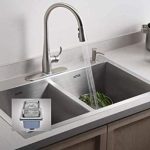A salt-based water softener invariably requires adding salt to the tank for performing the tasks that it is supposed to handle. Understanding the right way to add salt to the water softener is the key to improving the efficiency of the softener. That is precisely why we thought of checking out how to add salt to the water softener.
Adding salt to the water softener is an easy task. You need to locate the brine tank where the salt is stored. You need to open the lid and fill in the salt. The tank should be easy and easy to access.
What Type Of Salt Should You Use?
Sodium Chloride and Potassium Chloride are the two types of salts that are generally used in a water softeners. Among the salts that we mentioned, you can also use the different types of salts such as evaporated salt, solar salt, rock salt, and block salt.

The evaporated salt is the best option as it has the highest degree of purity. The order of preference for the best salt to be used in a water softener would include:
- Evaporated salt: It offers you a high degree of purity
- Solar salt: May not be soluble, but provides the second highest degree of purity
- Rock salt: It may not be much pure, but it comes with the calcium sulfate
- Block salt: Quite refined but requires the higher levels in the brine tank
- Potassium chloride: A good alternative to the sodium salt
How to Add Salt To The Water Softener?
Adding salt to a water softener involves up to seven steps. The steps you need to follow are quite easy and simple to follow.
Step 1: Buy the right type of salt
Buy the right type of the salt for your water softener. Ensure that the salt is in its purest form and also dissolves completely. It would be an ideal option to pick the salt in the pellets form.
Step 2: Turn off your water softener
You should check the brine tank before adding the salt to your softener. Do not forget to turn off the water softener before checking the brine tank
Step 3: Locate the brine tank
The brine tank is generally labeled as Brine or salt. If it is not labeled, you should check the manual that came with your water softener.
Step 4: Check the salt levels
Check the level of salt in the brine tank. Ideally, you will need to fill the tank if the brine tank is half full or even lesser. The level of salt should be above the level of water. If you find that the water level is higher, it is time to fill up the salt in the brine tank.
Step 5: Check for the cleanliness of the tank
The tank should have loose and free moving salt. If you find any chunks or lumps, break them up. Look for the formation of salt bridges, and if you find any of them, break them up.
Step 6: Check if the tank has a salt smudge
There may be salt mushing which is in the form of smudges. This can stop the water from flowing freely. It is advisable to remove the smudge and clean it thoroughly.
Step 7: Add the salt
Take a bag of salt and pour it into the brine tank. The salt should be added until you reach the level of the fill line. You should stop five to six inches below the top of the tank.
Step 8: Shut the lid of the tank
That should complete the task. Cover the tank and reassemble the water softener.
How Often Should You Add Salt to a Water Softener?
It is advisable to add salt every month to the water softener. You are expected to add one bag of salt to the tank every month. You can check the salt level at the beginning of each month and monitor the level of the salt. How often you need to add salt to the water softener will be dependent on several factors that would include the size of the tank, the age of the water softener, and the formation of salt bridges.

If you want to find out how often you should add salt to a water softener, it is advisable to follow the tips here below:
The size of the tank
Once you are accustomed to the system and working of your water softener, you will find it relatively easy and simple to find how often you should add salt to the water softener. Open the brine tank and check the level of salt. This will help you understand the pattern of the salt usage. The size of the tank will also determine the frequency of adding salt to the brine tank.
The age of the water softener
The age of the water softener should be yet another factor that would determine how often you need to add salt to the water softener. If your water softener is more than 10 years old, you will end up with more consumption of salt than the water. The newer models of water softeners work with on-demand water regeneration as opposed to the on-schedule regeneration.
How Much Salt Goes In A Water Softener?
If you are an average family of four members, the ideal amount of salt that would go into a system would be 6 to 8 pounds of salt each week, or around 40 pounds of salt each month. The amount of salt that goes into the water softener will largely be dependent on the size of the water softener and the water hardness in your region.
Water softeners generally regenerate once every week. In case your water softener regenerates between 5 to 7 times a week, you should require 40 pounds of salt every month. It is always a good idea to buy the high-purity salt with a minimum of 99.6% salt content.
How Much Salt Does a Water Softener Use?
The typical use of the salt that goes into the water softener under ideal conditions is around 8 pounds per week or 40 pounds per month. The exact amount is dependent on your family size, the size of the brine tank, and the age of your water softener. It will also be decided by the quality and purity of the salt that you are using with your water softener.
It is also ideal to choose the potassium salt instead of the sodium. While the potassium chloride is more economical when it comes to the usage pattern, it tends to form bridges.
Why It’s Important to Add Salt to Your Water Softener on Time?
With no proper amount of salt in the water softener, it will not work towards providing you the optimal regeneration. The softening capacity will not be restored to its fullest capability. This will make the hard water to continue through the taps in your plumbing system.
The following factors explain the importance and efficiency of why it is important to add salt to your water softener.
It helps you out in addressing the hard water issues
With no proper supply of salt in the brine tank, the water softener will not be able to work at its optimum level. If your water softener does not have the proper water regeneration capability, your home will continue to receive the hard water and the associated problems.
It can also help you in finding the maintenance needs of your water softener
You will be able to find the issues with the brine tank or water softener so that you will be aware of the signs of bridging and mushing. A few of the practical options would include encrusted salt, draining in your brine tank, and the ridiculously lower levels of salt.
What Happens if I Add Too Little or Too Much Salt?
You should check the brine tank consistency for an effective and efficient water softening process. Adding too much salt to the water softener can make it cause the appearance of salt bridges. It can also cause the buildup and solidification of the regenerant. Low salt can reduce the level of water softening capability.
Adding too much of salt to the water softener can cause the wide spread appearance and development of salt bridges. The salt bridges are formed when the salt sits at the top of the tank and forms the bridge. If you do not take enough care, these bridges can become something that you need to worry about a lot. They would stop a proper regeneration and water softening.
Too little salt can also have a few specific issues. It will not let you get a proper softening of the water, but can also manifest a few other symptoms such as:
- Orangish mineral staining
- White spots on the surfaces
- Less or no lather with soap or detergent.
What Happens if You Run Your Water Softener Without Salt?
Any water softener needs salt to operate effectively. With the proper amount of salt included in the brine tank, the softener will be able to remove the calcium and magnesium from the water. This may allow the hard water back into your plumbing system.
There will be no issues with your water softener if it begins to run without the salt. However, you are likely to run into issues that can be caused due to the hard water. You will begin getting the hard water in your water system, and that can cause havoc with your devices and equipment, such as heaters and other issues.
The Parting Thoughts
To get the best and proper functionality with your water softener, it is always advisable to add the right amount of salt to the water softener at regular intervals. The process involved in refilling the water softener is quite a simple and easy option to go with. Ensuring the proper supply of salt in the water softener is an easier option.












Add Comment